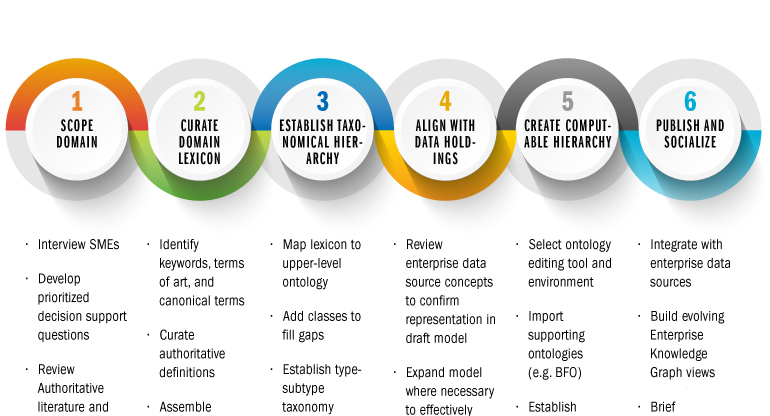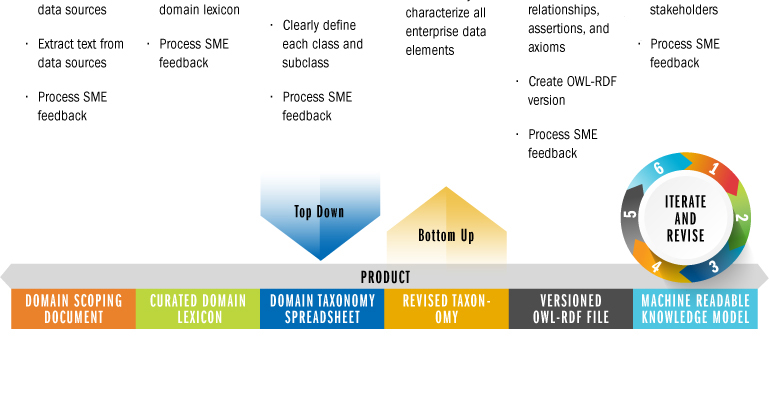

JADC2: Connected Battlespace Will Need Strong Modeling for Data Alignment
Truly effective knowledge models require both a top-down and bottom-up ontology development approach

Blog Posts
COSIKnE Process Leads to U.S. Armed Forces Data Integration
At SAIC, we have developed and refined a six-step process for developing ontology-based knowledge models for our government customers to help them bridge the gap between data and decision-making. In fact, this process supports all of SAIC’s work related to constructing ontologies, semantic integration, and knowledge engineering — or “COSIKnE.” The six-step process allows us to build knowledge models and their components systematically and rigorously with logical frameworks that enable semantic integration and computationally assisted reasoning of data from information systems that are oftentimes disparate.
In a previous blog, we discussed how during step 5 we create computable ontologies that can semantically link the disparate data sets and terminologies of each U.S. armed services branch for the Department of Defense’s joint all-domain command-and-control (JADC2) strategy. Conducting steps 3 and 4 in tandem is equally important because it ensures that the knowledge models produced by our experts are logical and can be integrated into users’ existing data holdings.
In establishing a taxonomical hierarchy (Step 3), we extend an upper-level ontology standard, such as the Basic Formal Ontology (BFO), to domain terms and their relationships. This step is important because it ensures that all sub-classes follow logically from their parent. Also, it guarantees the knowledge model’s interoperability with all other knowledge models that follow the same ontology standard, through the semantic and relational connections.
Think of the BFO as an intermediary reference system like musical symbols and notations. A Russian violinist can sit with the English-speaking Boston Symphony Orchestra, read a sheet of music, and play the piece without missing a note. Adherence to an ontology standard like the BFO is thus critical as the military branches and echelons develop their knowledge models, as it will semantically link all of them for the JADC2 connected battlespace.
Semantic integration enables human-to-human and computer-to-computer information exchange across the entire U.S. armed forces. An important benefit is that artificial intelligence can be applied in an auditable fashion for computationally assisted reasoning, interpretation, and automation. However, following only this "top-down" approach in step 3 to representing domain knowledge in a knowledge model could lead to generation of an incomplete representation of the domain of interest. This incomplete representation will limit the user's ability to answer decision-support questions effectively.
In our knowledge modeling support for customers, we are careful to also complete step 4 in the COSIKnE process, looking at enterprise data holdings to confirm that each piece of stored data is accurately represented in the knowledge model produced from step 3. Aligning the knowledge model with data holdings in this “bottom-up” fashion is important to ensure that the user can make the fullest use of existing enterprise data.
When encountering data elements not represented accurately or at all in the knowledge model, we must add the appropriate class, object relationship, datatype property, or a combination thereof. This ensures that the existing data holdings are given the right semantic meanings in the knowledge model.
We have seen knowledge model development efforts that establish a taxonomical hierarchy but don’t align existing data with it. The customer receives a logical, well-organized reference ontology that cannot be used to gain knowledge from existing data holdings. The gap between the knowledge model and existing data can be so great that data modelers and database engineers cannot effectively apply the ontology.
On the other hand, building a hierarchy by only organizing current data holdings in some taxonomical fashion presents equally serious risks. The resultant model might not follow a logical formulation to allow for inferencing with the data and to allow the employment of intelligent agents that otherwise would leverage the logic to identify new knowledge. The model also might not be interoperable with other models and adapt well to the integration of new data sources.
One of the powers of the linked data approach, embodied by machine-readable ontologies, is the ability to easily link disparate data sets when the knowledge models are very similar. Tailoring a model to only one set of data misses on one of the most important advantages of ontology-based knowledge modeling, which is the “plug-in” of a new data stream and its semantic meaning to derive new insights. For this reason, both the top-down and bottom-up approaches must be followed to generate a truly powerful result for our customers.
When leveraging a knowledge model based on all the steps in the COSIKnE process, a planner or an analyst can make an observation or assertion about an object in the battlespace, and it will be automatically linked with assertions made by other operators on perhaps disparate information systems. This process facilitates distributed situational awareness and decision-making for joint all-domain operations commanders.
For more on joint all-domain command and control, visit SAIC's JADC2 solutions site.
MORE ONTOLOGY AND SEMANTIC FRAMEWORK EXPERTISE FROM SAIC: Ontologies for data fusion and reasoning rise with growth in advanced analytics



